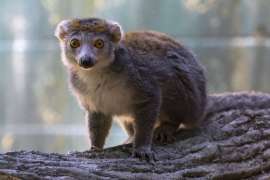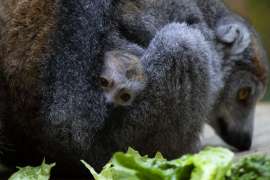Crowned Lemur
Crowned Lemur
Crowned lemurs, like all lemurs, are primates only found on the island of Madagascar, off the southeastern coast of Africa. Out of all lemur species, crowned lemurs are the most sexually dimorphic, meaning males and females look very different. They are an endangered species, threatened by habitat loss and are hunted for food and the pet trade.
Eulemur coronatus
Frugivore
Madagascar
Dry Forests, Rainforests
Search for them first thing in the morning while they are exploring their habitat. They are usually seen lounging on the large tree in midday.
Photos and Videos
Crowned lemurs, like all lemurs, are primates only found on the island of Madagascar, off the southeastern coast of Africa. Out of all lemur species, crowned lemurs are the most sexually dimorphic, meaning males and females look very different. They are an endangered species, threatened by habitat loss and are hunted for food and the pet trade.
Crowned lemurs forage at all levels of the forest canopy for fruits and leaves and sometimes insects. They are primarily diurnal—active from sunrise to sunset—but occasionally travel after nightfall. Lifespan in the wild is 15-20 years; in zoos 30 years.
With the exception of the blue-eyed lemur, crowned lemurs are the most noticeably sexually dichromatic lemur species, meaning that males and females display different colors. The females are predominantly gray with an orange crown, while the males are a much darker reddish brown with a black and orange crown. They weigh around 3 to 3.5 pounds.
In the wild, crowned lemurs live in close-knit social groups of five to six individuals led by dominant females. Singletons and twins are equally common, and their young are born seasonally. Their gestation period is around four and a half months, and mothers nurse their young for five to seven months. Crowned lemurs reach maturity at 20 months of age and sexual maturity at 3 years old.
Like all lemur species, crowned lemurs have a dental “comb” formed by the lower six incisors and canine teeth. They spend much of their time grooming themselves and each other with this comb and claws well-adapted to the purpose.
Search for them first thing in the morning while they are exploring their habitat. They are usually seen lounging on the large tree in midday.
Crowned lemurs are found only in the northernmost area of Madagascar.
The species inhabits dry, deciduous forest and mid-altitude rainforest situated on rugged, limestone-shaped terrain.
Their wild diet consists mainly of fruits, supplemented with young leaves, flowers and pollen; insects and soil are also eaten on occasion. The animals tend to rely heavily on 10 to 20 percent of the nearly 100 plant species they exploit, and feed more on flowers during the dry season than at other times of the year. Although the diet of crowned lemurs varies with the seasons, it contains a high percentage of fruit with relatively few leaves. During both wet and dry seasons, fruit comprises as much as 80 to 90 percent of the crowned lemur diet.
Their Zoo diet consists of high-fiber chow sticks, browse biscuits, peas, peppers, cauliflower, broccoli, collards, kale, cabbage, mango, papaya, orange and cantaloupe.
Crowned lemurs are endemic to the country of Madagascar and are currently listed as Endangered by IUCN due to severely fragmented habitat and a decline in the quality of habitat within the range of the species, mainly due to slash-and-burn agriculture, charcoal production, mining for sapphires and gold and illegal logging. The species is also hunted for food, persecuted by humans for their occasional raids on crops, and captured for the local pet trade.
Many lemur species are on the brink of extinction. With 91 percent of all lemur species and subspecies classified as Critically Endangered, Endangered or Vulnerable on the International Union for the Conservation of Nature (IUCN) Red List of Threatened Species, lemurs are the most threatened group of mammals worldwide.
Madagascar, the only place in the world where lemurs are found, is home to 110 species of lemurs and is a global hotspot of biodiversity. Only 10 percent of Madagascar’s land area remains as suitable primate habitat. Lemurs are threatened by habitat loss and deforestation, and they could be extinct in 20 years without targeted conservation efforts.
Zoo Atlanta supports Madagascar Fauna Foundation through money raised through Wild Encounter programs.



